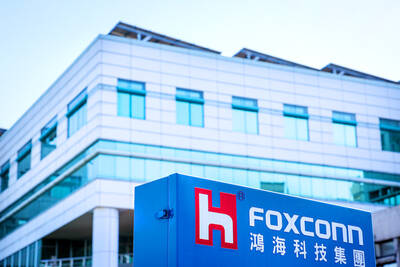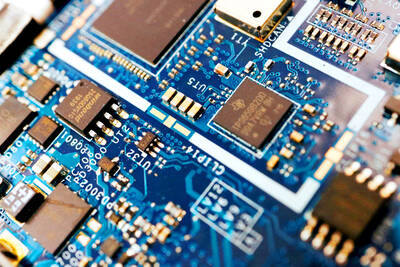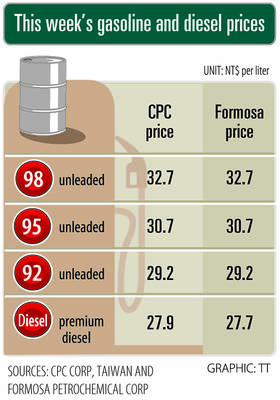Taiwan’s manufacturing output in the second quarter fell 19.57 percent year-on-year to NT$4.21 trillion (US$131.8 billion) as manufacturers’ capacity utilization remained under pressure from weakening end-market consumption, decelerated investment momentum and continuous inventory adjustments, the Ministry of Economic Affairs said in a statement on Friday.
It was the third consecutive quarter of annual decline following a fall of 13.59 percent in the first quarter of the year and a decline of 5.73 percent in the fourth quarter of last year, as firms in the technological as well as traditional industries continued to face headwinds amid a slowdown in the global economy, the ministry said.
The outlook for the domestic manufacturing sector is still being weighed down by the effects of global inflation and monetary tightening, as well as the conflict between Russia and Ukraine and US-China technology disputes, it said.

Photo: Ritchie B. Tongo, EPA-EFE
However, potential business opportunities related to high-performance computing, artificial intelligence and automotive electronics, coupled with launches of new consumer electronics, could help inject some growth momentum into the local manufacturing sector in the second half of the year, it added.
During the April-to-June quarter, the electronic components industry — the manufacturing sector’s most important segment, with a share of 28.72 percent in the sector’s total output — saw production value decrease by 22.7 percent to NT$1.21 trillion last quarter, driven mainly by a fall of 25.2 percent in semiconductor industry output to NT$704.3 billion amid weakening demand for electronic products and persistent inventory adjustments, ministry data showed.
In addition, LCD panel makers reported a 14.02 percent decline in output to NT$136.9 billion due to weakening demand for new applications and falling prices compared with a year earlier, while suppliers of computers and optical products also saw output drop 3.38 percent to NT$261 billion as consumption shrank, although the decrease was better than expected thanks to solid demand for servers and networking equipment, the ministry said.
In traditional industries, producers of chemical materials and fertilizers last quarter posted a decline of 35.99 percent year-on-year to NT$383.4 billion, while suppliers of base metals reported that their output declined 27.36 percent to NT$380.2 billion. Output at makers of machinery equipment decreased by 16.59 percent to NT$220.6 billion.
The declines mainly reflect the effects of a slowing global economy, the ministry said, adding that manufacturers implementing annual maintenance and reducing capacity utilization while customers kept up inventory destocking, coupled with a decreased willingness to invest, were also factors behind the fall in production.
In comparison, the automobile and vehicle parts industry’s output grew 10.7 percent year-on-year to NT$127 billion last quarter, the fourth straight quarter of annual increase, on the back of a steady supply of auto chips and components, as well as strong sales of several new car models and higher component prices compared with a year earlier, it said.

Hon Hai Precision Industry Co (鴻海精密) yesterday said that its research institute has launched its first advanced artificial intelligence (AI) large language model (LLM) using traditional Chinese, with technology assistance from Nvidia Corp. Hon Hai, also known as Foxconn Technology Group (富士康科技集團), said the LLM, FoxBrain, is expected to improve its data analysis capabilities for smart manufacturing, and electric vehicle and smart city development. An LLM is a type of AI trained on vast amounts of text data and uses deep learning techniques, particularly neural networks, to process and generate language. They are essential for building and improving AI-powered servers. Nvidia provided assistance

GREAT SUCCESS: Republican Senator Todd Young expressed surprise at Trump’s comments and said he expects the administration to keep the program running US lawmakers who helped secure billions of dollars in subsidies for domestic semiconductor manufacturing rejected US President Donald Trump’s call to revoke the 2022 CHIPS and Science Act, signaling that any repeal effort in the US Congress would fall short. US Senate Minority Leader Chuck Schumer, who negotiated the law, on Wednesday said that Trump’s demand would fail, while a top Republican proponent, US Senator Todd Young, expressed surprise at the president’s comments and said he expects the administration to keep the program running. The CHIPS Act is “essential for America leading the world in tech, leading the world in AI [artificial

DOMESTIC SUPPLY: The probe comes as Donald Trump has called for the repeal of the US$52.7 billion CHIPS and Science Act, which the US Congress passed in 2022 The Office of the US Trade Representative is to hold a hearing tomorrow into older Chinese-made “legacy” semiconductors that could heap more US tariffs on chips from China that power everyday goods from cars to washing machines to telecoms equipment. The probe, which began during former US president Joe Biden’s tenure in December last year, aims to protect US and other semiconductor producers from China’s massive state-driven buildup of domestic chip supply. A 50 percent US tariff on Chinese semiconductors began on Jan. 1. Legacy chips use older manufacturing processes introduced more than a decade ago and are often far simpler than

Gasoline and diesel prices this week are to decrease NT$0.5 and NT$1 per liter respectively as international crude prices continued to fall last week, CPC Corp, Taiwan (CPC, 台灣中油) and Formosa Petrochemical Corp (台塑石化) said yesterday. Effective today, gasoline prices at CPC and Formosa stations are to decrease to NT$29.2, NT$30.7 and NT$32.7 per liter for 92, 95 and 98-octane unleaded gasoline respectively, while premium diesel is to cost NT$27.9 per liter at CPC stations and NT$27.7 at Formosa pumps, the companies said in separate statements. Global crude oil prices dropped last week after the eight OPEC+ members said they would